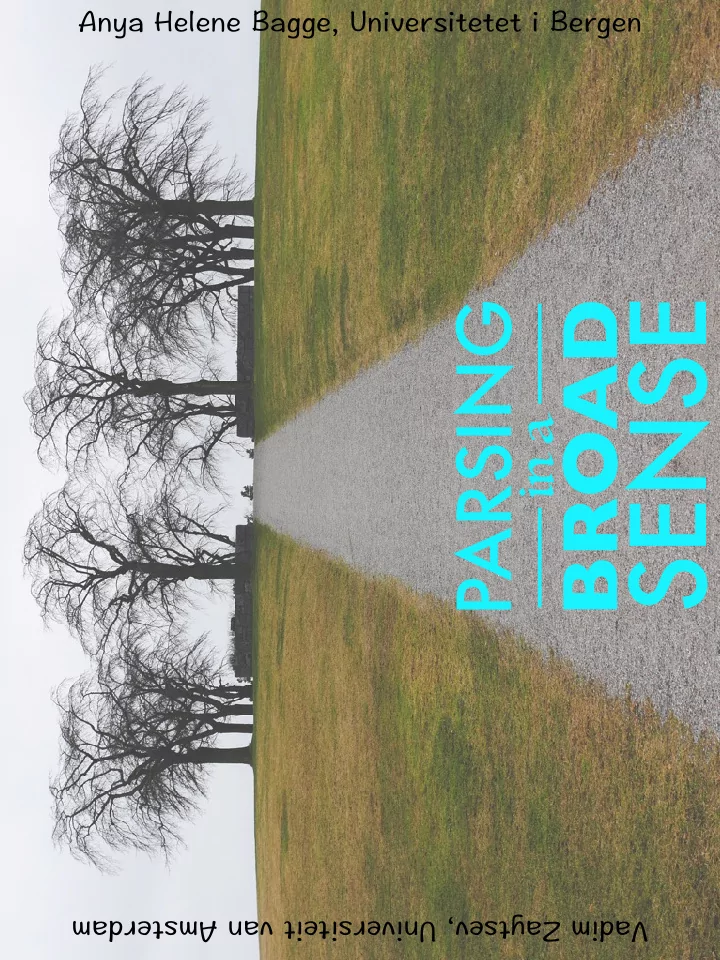

����������������������������������������� ������������������������������������������ SENSE PARSING BROAD in a
3.1 Two classes of parsing methods 117 3.1 Two classes of parsing methods A parsing method constructs the syntax tree for a given sequence of tokens. Con- structing the syntax tree means that a tree of nodes must be created and that these nodes must be labeled with grammar symbols, in such a way that: • leaf nodes are labeled with terminals and inner nodes are labeled with non- terminals; • the top node is labeled with the start symbol of the grammar; • the children of an inner node labeled N correspond to the members of an alterna- tive of N , in the same order as they occur in that alternative; • the terminals labeling the leaf nodes correspond to the sequence of tokens, in the same order as they occur in the input. Left-to-right parsing starts with the first few tokens of the input and a syntax tree, which initially consists of the top node only. The top node is labeled with the start symbol. The parsing methods can be distinguished by the order in which they construct the nodes in the syntax tree: the top-down method constructs them in pre-order, the bottom-up methods in post-order. A short introduction to the terms “pre-order” and “post-order” can be found below. The top-down method starts at the top and con- structs the tree downwards to match the tokens in the input; the bottom-up methods combine the tokens in the input into parts of the tree to finally construct the top node. The two methods do quite different things when they construct a node. We will first explain both methods in outline to show the similarities and then in enough detail to design a parser generator. Note that there are three different notions involved here: visiting a node , which means doing something with the node that is significant to the algorithm in whose service the traversal is performed; traversing a node , which means visiting that node and traversing its subtrees in some order; and traversing a tree , which means travers- ing its top node, which will then recursively traverse the entire tree. “Visiting” be- longs to the algorithm; “traversing” in both meanings belongs to the control mech- anism. This separates two concerns and is the source of the usefulness of the tree traversal concept. In everyday speech these terms are often confused, though. 3.1.1 Principles of top-down parsing A top-down parser begins by constructing the top node of the tree, which it knows to be labeled with the start symbol. It now constructs the nodes in the syntax tree in pre-order, which means that the top of a subtree is constructed before any of its lower nodes are. When the top-down parser constructs a node, the label of the node itself is already known, say N ; this is true for the top node and we will see that it is true for all other nodes as well. Using information from the input, the parser then determines the Grune, van Reeuwijk, Bal, Jacobs, Langendoen, Modern Compiler Design, 2ed
3.1 Two classes of parsing methods 117 3.1 Two classes of parsing methods A parsing method constructs the syntax tree for a given sequence of tokens. Con- structing the syntax tree means that a tree of nodes must be created and that these nodes must be labeled with grammar symbols, in such a way that: • leaf nodes are labeled with terminals and inner nodes are labeled with non- terminals; • the top node is labeled with the start symbol of the grammar; • the children of an inner node labeled N correspond to the members of an alterna- tive of N , in the same order as they occur in that alternative; • the terminals labeling the leaf nodes correspond to the sequence of tokens, in the same order as they occur in the input. Left-to-right parsing starts with the first few tokens of the input and a syntax tree, which initially consists of the top node only. The top node is labeled with the start symbol. The parsing methods can be distinguished by the order in which they construct the nodes in the syntax tree: the top-down method constructs them in pre-order, the bottom-up methods in post-order. A short introduction to the terms “pre-order” and “post-order” can be found below. The top-down method starts at the top and con- Grune, van Reeuwijk, Bal, Jacobs, Langendoen, Modern Compiler Design, 2ed
Recommend
More recommend